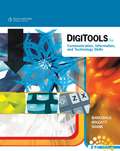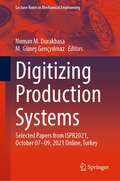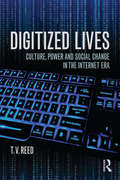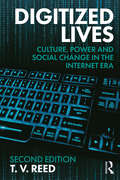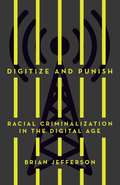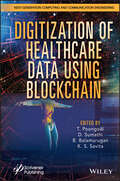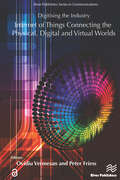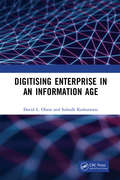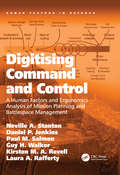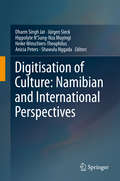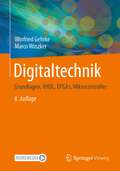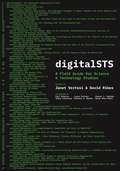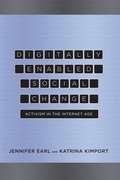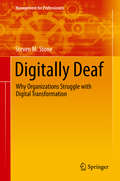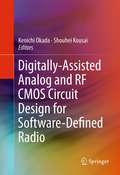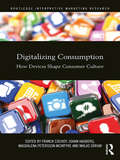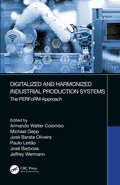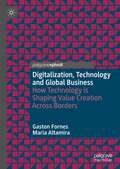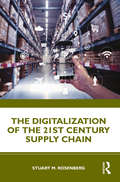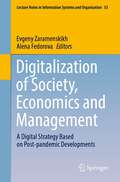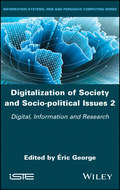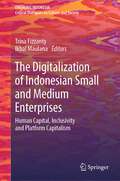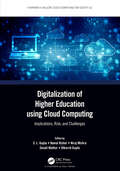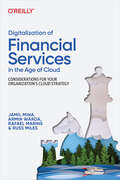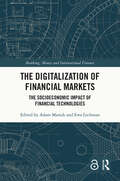- Table View
- List View
Digitools: Communication, Information, and Technology Skills
by Karl Barksdale Jack P. Hoggatt Jon A. ShankNo other book better prepares students for the innovations in Microsoft Office (2010 and 2007) and living in today's digital world like the third edition of DIGITOOLS! DIGITOOLS emphasizes computer applications, such as word processing, presentations, spreadsheets, and database while also providing instruction on the proper way to key and format documents using proven instructional methods, Students learn to effectively use the Internet and input technologies, including speech and handwriting recognition.
Digitizing Production Systems: Selected Papers from ISPR2021, October 07-09, 2021 Online, Turkey (Lecture Notes in Mechanical Engineering)
by Numan M. Durakbasa M. Güneş GençyılmazThis book contains selected papers from International Symposium for Production Research 2021, held on October 7–9, 2021, online, Turkey. The book reports recent advances in production engineering and operations. It explores topics including production research;production management; operations management;industry 4.0;industrial engineering;mechanical engineering;engineering management; andoperational research. Presenting real-life applications, case studies, and mathematical models, this book is of interest to researchers, academics, and practitioners in the field of production and operation engineering. It provides both the results of recent research and practical solutions to real-world problems.
Digitized Lives: Culture, Power, and Social Change in the Internet Era
by T. V. ReedIn a remarkably short period of time the Internet and associated digital communication technologies have deeply changed the way millions of people around the globe live their lives. But what is the nature of that impact? In chapters examining a broad range of issues—including sexuality, politics, education, race, gender relations, the environment, and social protest movements—Digitized Lives seeks answers to these central questions: What is truly new about so-called "new media," and what is just hype? How have our lives been made better or worse by digital communication technologies? In what ways can these devices and practices contribute to a richer cultural landscape and a more sustainable society? Cutting through the vast—and often contradictory—literature on these topics, Reed avoids both techno-hype and techno-pessimism, offering instead succinct, witty and insightful discussions of how digital communication is impacting our lives and reshaping the major social issues of our era. The book argues that making sense of digitized culture means looking past the glossy surface of techno gear to ask deeper questions about how we can utilize technology to create a more socially, politically, and economically just world. Companion website available at: culturalpolitics.net/digital_cultures
Digitized Lives: Culture, Power and Social Change in the Internet Era
by T. V. ReedIn chapters examining a broad range of issues—including sexuality, politics, education, race, gender relations, the environment and social protest movements—Digitized Lives argues that making sense of digitized culture means looking past the glossy surface of techno gear to ask deeper questions about how we can utilize technology to create a more socially, politically and economically just world. This second edition includes important updates on mobile and social media, examining how new platforms and devices have altered how we interact with digital technologies in an allegedly ‘post-truth’ era. A companion website (www.culturalpolitics.net/digital_cultures) includes links to online articles and useful websites, as well as a bibliography of offline resources, and more.
Digitize and Punish: Racial Criminalization in the Digital Age
by Brian JeffersonTracing the rise of digital computing in policing and punishment and its harmful impact on criminalized communities of color The U.S. Bureau of Justice Statistics estimates that law enforcement agencies have access to more than 100 million names stored in criminal history databases. In some cities, 80 percent of the black male population is registered in these databases. Digitize and Punish explores the long history of digital computing and criminal justice, revealing how big tech, computer scientists, university researchers, and state actors have digitized carceral governance over the past forty years—with devastating impact on poor communities of color.Providing a comprehensive study of the use of digital technology in American criminal justice, Brian Jefferson shows how the technology has expanded the wars on crime and drugs, enabling our current state of mass incarceration and further entrenching the nation&’s racialized policing and punishment. After examining how the criminal justice system conceptualized the benefits of computers to surveil criminalized populations, Jefferson focuses on New York City and Chicago to provide a grounded account of the deployment of digital computing in urban police departments.By highlighting the intersection of policing and punishment with big data and web technology—resulting in the development of the criminal justice system&’s latest tool, crime data centers—Digitize and Punish makes clear the extent to which digital technologies have transformed and intensified the nature of carceral power.
Digitization of Healthcare Data using Blockchain
by T. Poongodi D. Sumathi B. Balamurugan K. S. SavitaDIGITIZATION OF HEALTHCARE DATA USING BLOCKCHAIN The book gives a detailed description of the integration of blockchain technology for Electronic Health Records and provides the research challenges to consider in various disciplines such as supply chain, drug discovery, and data management. The aim of the book is to investigate the concepts of blockchain technology and its association with the recent development and advancements in the medical field. Moreover, it focuses on the integration of workflow strategies like NLP, and AI which could be adopted for boosting the clinical documentation and electronic healthcare records (EHR) usage by bringing down the physician EHR data entry. Also, the book covers the usage of smart contracts for securing patient records. Digitization of Healthcare Data Using Blockchain presents the practical implementations that deal with developing a web framework for building highly usable healthcare applications, a simple blockchain-powered EHR system. Audience Researchers in information technology, artificial intelligence, electronics engineering, medical informatics, as well as policymakers and healthcare providers and management systems.
Digitising the Industry Internet of Things Connecting the Physical, Digital and VirtualWorlds
by Ovidiu Vermesan Peter FriessThis book provides an overview of the current Internet of Things (IoT) landscape, ranging from the research, innovation and development priorities to enabling technologies in a global context. A successful deployment of IoT technologies requires integration on all layers, be it cognitive and semantic aspects, middleware components, services, edge devices/machines and infrastructures. It is intended to be a standalone book in a series that covers the Internet of Things activities of the IERC - Internet of Things European Research Cluster from research to technological innovation, validation and deployment. The book builds on the ideas put forward by the European Research Cluster and the IoT European Platform Initiative (IoT-EPI) and presents global views and state of the art results on the challenges facing the research, innovation, development and deployment of IoT in the next years. The IoT is bridging the physical world with virtual world and requires sound information processing capabilities for the "digital shadows" of these real things. The research and innovation in nanoelectronics, semiconductor, sensors/actuators, communication, analytics technologies, cyber-physical systems, software, swarm intelligent and deep learning systems are essential for the successful deployment of IoT applications. The emergence of IoT platforms with multiple functionalities enables rapid development and lower costs by offering standardised components that can be shared across multiple solutions in many industry verticals. The IoT applications will gradually move from vertical, single purpose solutions to multi-purpose and collaborative applications interacting across industry verticals, organisations and people, being one of the essential paradigms of the digital economy. Many of those applications still have to be identified and involvement of end-users including the creative sector in this innovation is crucial. The IoT applications and deployments as integrated building blocks of the new digital economy are part of the accompanying IoT policy framework to address issues of horizontal nature and common interest (i.e. privacy, end-to-end security, user acceptance, societal, ethical aspects and legal issues) for providing trusted IoT solutions in a coordinated and consolidated manner across the IoT activities and pilots. In this, context IoT ecosystems offer solutions beyond a platform and solve important technical challenges in the different verticals and across verticals. These IoT technology ecosystems are instrumental for the deployment of large pilots and can easily be connected to or build upon the core IoT solutions for different applications in order to expand the system of use and allow new and even unanticipated IoT end uses. Technical topics discussed in the book include: • Introduction• Digitising industry and IoT as key enabler in the new era of Digital Economy• IoT Strategic Research and Innovation Agenda• IoT in the digital industrial context: Digital Single Market• Integration of heterogeneous systems and bridging the virtual, digital and physical worlds• Federated IoT platforms and interoperability• Evolution from intelligent devices to connected systems of systems by adding new layers of cognitive behaviour, artificial intelligence and user interfaces.• Innovation through IoT ecosystems• Trust-based IoT end-to-end security, privacy framework• User acceptance, societal, ethical aspects and legal issues• Internet of Things Applications
Digitising Enterprise in an Information Age
by David L. Olson Subodh KesharwaniDigitising Enterprise in an Information Age is an effort that focuses on a very vast cluster of Enterprises and their digitising technology involvement and take us through the road map of the implementation process in them, some of them being ICT, Banking, Stock Markets, Textile Industry & ICT, Social Media, Software Quality Assurance, Information Systems Security and Risk Management, Employee Resource Planning etc. It delves on increased instances of cyber spamming and the threat that poses to e-Commerce and Banking and tools that help and Enterprise toward of such threats. To quote Confucius, “As the water shapes itself to the vessel that contains it, so does a wise man adapts himself to circumstances.” And the journey of evolution and progression will continue and institutions and enterprises will continue to become smarter and more and more technology savvy. Enterprises and businesses across all genre and spectrum are trying their level best to adopt to change and move on with the changing requirements of technology and as enterprises and companies upgrade and speed up their digital transformations and move their outdate heirloom systems to the cloud, archaic partners that don't keep up will be left behind. Note: T&F does not sell or distribute the Hardback in India, Pakistan, Nepal, Bhutan, Bangladesh and Sri Lanka.
Digitising Command and Control: A Human Factors and Ergonomics Analysis of Mission Planning and Battlespace Management (Human Factors in Defence)
by Neville A. Stanton Daniel P. Jenkins Paul M. Salmon Guy H. Walker Kirsten M. Revell Laura A. RaffertyThis book presents a human factors and ergonomics evaluation of a digital Mission Planning and Battle-space Management (MP/BM) system. An emphasis was placed on the activities at the Brigade (Bde) and the Battle Group (BG) headquarters (HQ) levels. The analysts distributed their time evenly between these two locations. The human factors team from Brunel University, as part of the HFI DTC, undertook a multi-faceted approach to the investigation, including: - observation of people using the traditional analogue MP/BM processes in the course of their work - cognitive work analysis of the digital MP/BM system - analysis of the tasks and goal structure required by the digital MP/BM - assessment against a usability questionnaire - analysis of the distributed situation awareness - an environmental survey. The book concludes with a summary of the research project's findings and offers many valuable insights. For example, the recommendations for short-term improvements in the current generation of digital MP/BM system address general design improvements, user-interface design improvements, hardware improvements, infrastructure improvements and support improvements. In looking forward to the next generation digital MP/BM systems, general human factors design principles are presented and human factors issues in digitising mission planning are considered.
Digitisation of Culture: Namibian and International Perspectives
by Shawulu Nggada Anicia Peters Heike Winschiers-Theophilus Hippolyte N'Sung-Nza Muyingi Jürgen Sieck Dharm Singh JatThis book explores the digitization of culture as a means of experiencing and understanding cultural heritage in Namibia and from international perspectives. It provides various views and perspectives on the digitization of culture, the goal being to stimulate further research, and to rapidly disseminate related discoveries. Aspects covered here include: virtual and augmented reality, audio and video technology, art, multimedia and digital media integration, cross-media technologies, modeling, visualization and interaction as a means of experiencing and grasping cultural heritage. Over the past few decades, digitization has profoundly changed our cultural experience, not only in terms of digital technology-based access, production and dissemination, but also in terms of participation and creation, and learning and partaking in a knowledge society. Computing researchers have developed a wealth of new digital systems for preserving, sharing and interacting with cultural resources. The book provides important information and tools for policy makers, knowledge experts, cultural and creative industries, communication scientists, professionals, educators, librarians and artists, as well as computing scientists and engineers conducting research on cultural topics.
Digitaltechnik: Grundlagen, VHDL, FPGAs, Mikrocontroller
by Winfried Gehrke Marco WinzkerModerne Digitaltechnik, umfassend und kompakt: Dieses Lehr- und Übungsbuch spannt den Bogen von den Grundlagen der Digitaltechnik über den Entwurf mit VHDL und Komponenten digitaler Systeme bis zu modernen Mikrocontrollern der STM32-Serie.Digitale Grundelemente wie Logikgatter und Flip-FlopsKombinatorische und sequenzielle SchaltungenSchaltungsentwurf und Simulation mit VHDLProgrammierbare Logikbausteine: CPLDs, FPGAsHalbleiterspeicherA/D- und D/A-UmsetzerArchitektur von MikroprozessorenProgrammierung von Arm® CortexTM Mikroprozessoren in C und Assembler32-Bit-Mikrocontroller der STM32-FamilieFunktion und Programmierung von STM32-Peripheriemodulen Die 8. Auflage wurde aktualisiert und die Themenbereiche Mikroprozessoren und Mikrocontroller grundlegend überarbeitet.Zahlreiche Beispiele erleichtern das Verständnis. Viele Übungsaufgaben mit Musterlösungen unterstützen die Lernkontrolle und stehen zu jedem Kapitel zur Verfügung. Ergänzendes Material wird auf der Webseite zum Buch angeboten.Das Buch ist so konzipiert, dass es sowohl als Begleitlektüre von Lehrveranstaltungen als auch für das Selbststudium in den Bereichen Digitaltechnik, Mikrocontroller und Systementwurf geeignet ist.
digitalSTS: A Field Guide for Science & Technology Studies
by Janet Vertesi David RibesScholars across the humanities, social sciences, and information sciences are grappling with how best to study virtual environments, use computational tools in their research, and engage audiences with their results. Classic work in science and technology studies (STS) has played a central role in how these fields analyze digital technologies, but many of its key examples do not speak to today’s computational realities. This groundbreaking collection brings together a world-class group of contributors to refresh the canon for contemporary digital scholarship.In twenty-five pioneering and incisive essays, this unique digital field guide offers innovative new approaches to digital scholarship, the design of digital tools and objects, and the deployment of critically grounded technologies for analysis and discovery. Contributors cover a broad range of topics, including software development, hackathons, digitized objects, diversity in the tech sector, and distributed scientific collaborations. They discuss methodological considerations of social networks and data analysis, design projects that can translate STS concepts into durable scientific work, and much more.Featuring a concise introduction by Janet Vertesi and David Ribes and accompanied by an interactive microsite, this book provides new perspectives on digital scholarship that will shape the agenda for tomorrow’s generation of STS researchers and practitioners.
Digitally Enabled Social Change: Activism in the Internet Age
by Jennifer Earl Katrina KimportAn investigation into how specific Web technologies can change the dynamics of organizing and participating in political and social protest. Much attention has been paid in recent years to the emergence of "Internet activism," but scholars and pundits disagree about whether online political activity is different in kind from more traditional forms of activism. Does the global reach and blazing speed of the Internet affect the essential character or dynamics of online political protest? In Digitally Enabled Social Change, Jennifer Earl and Katrina Kimport examine key characteristics of web activism and investigate their impacts on organizing and participation. Earl and Kimport argue that the web offers two key affordances relevant to activism: sharply reduced costs for creating, organizing, and participating in protest; and the decreased need for activists to be physically together in order to act together. Drawing on evidence from samples of online petitions, boycotts, and letter-writing and e-mailing campaigns, Earl and Kimport show that the more these affordances are leveraged, the more transformative the changes to organizing and participating in protest.
Digitally Deaf: Why Organizations Struggle with Digital Transformation (Management for Professionals)
by Steven M. StoneCompanies across all industries are leveraging digital technologies to transform outdated processes and build new business models to compete in the information age. For all the publicity and hype, successful digital transformation has proven to be elusive. Numerous studies have found more than half of all digital transformation efforts fail. Digitally Deaf explores the obstacles and inhibitors that derail transformation efforts and outlines the steps organizations should take to establish an environment for success. Written by a highly experienced CIO, Digitally Deaf illustrates symptoms and underlying issues through the author’s experiences at large, Fortune 250 organizations. Digitally Deaf establishes a framework for digital transformation execution beginning with the development of a common definition and language for transformation. Learn the roles of the board of directors and leadership in establishing the appropriate messaging, governance, and organizational structure to drive digital efforts. Realize how digital transformation efforts amplify common problems encountered in typical technology projects. Discover how the IT organization must transform to enable the agility needed to fuel new digital business models. Finally, learn to spot the symptoms of issues that undermine transformation success and how to address them.“On the topic of digital transformation, Steve addresses the mind set shift that is needed to be successful, leveraging relatable examples across multiple industries. Digitally Deaf offers a very relevant perspective on what it takes to move a traditional organization into the digital age.” Boris Sherman, CTO Tailored Brands “Stone, as a former CIO, accurately outlines the challenges associated with new technologies and the benefits of implementing a digital-first culture. This book helps business and technology leaders understand the landscape and how to embrace digital to create new sources of value in their organizations.” Jonathan Brassington, Head, Capgemini Invent North America
Digitally-Assisted Analog and RF CMOS Circuit Design for Software-Defined Radio
by Shouhei Kousai Kenichi OkadaThis book describes the state-of-the-art in RF, analog, and mixed-signal circuit design for Software Defined Radio (SDR). It synthesizes for analog/RF circuit designers the most important general design approaches to take advantage of the most recent CMOS technology, which can integrate millions of transistors, as well as several real examples from the most recent research results.
Digitalizing Consumption: How devices shape consumer culture (Routledge Interpretive Marketing Research)
by Franck Cochoy Johan Hagberg Magdalena Petersson McIntyre Niklas SörumContemporary consumer society is increasingly saturated by digital technology, and the devices that deliver this are increasingly transforming consumption patterns. Social media, smartphones, mobile apps and digital retailing merge with traditional consumption spheres, supported by digital devices which further encourage consumers to communicate and influence other consumers to consume. Through a wide range of empirical studies which analyse the impact of digital devices, this volume explores the digitization of consumption and shows how consumer culture and consumption practices are fundamentally intertwined and mediated by digital devices. Exploring the development of new consumer cultures, leading international scholars from sociology, marketing and ethnology examine the effects on practices of consumption and marketing, through topics including big data, digital traces, streaming services, wearables, and social media’s impact on ethical consumption. Digitalizing Consumption makes an important contribution to practice-based approaches to consumption, particularly the use of market devices in consumers’ everyday consumer life, and will be of interest to scholars of marketing, cultural studies, consumer research, organization and management.
Digitalized and Harmonized Industrial Production Systems: The PERFoRM Approach
by Armando Walter Colombo Michael Gepp José Barata Paulo Leitao José Barbosa Jeffrey WermannOn the one side, Industrial competitiveness today means shorter product lifecycles, increased product variety, and shorter times to market and customized tangible products and services. To face these challenges, the manufacturing industry is forced to move from traditional management, control, and automation approaches towards industrial cyber-physical systems. On the other side, several emergent engineering approaches and related Information‐Communication‐Control‐Technologies, such as Multi‐Agent-Systems, Service‐Oriented Architecture, Plug‐and‐Produce Systems, Cloud and Fog Technologies, Big Data and Analytics, among others, have been researched during the last years. The confluence of those results with the latest developments in Industrial Digitalization, Systems‐of‐Cyber-Physical-Systems Engineering, Internet‐of‐Things, Internet‐of‐Services, and Industry 4.0 is opening a new broad spectrum of innovation possibilities. The PERFoRM (Production-harmonizEd-Reconfiguration of Flexible Robots and Machinery) approach is one of them. It teaches the reader what it means when production machines and systems are digitalized and migrated into Industrial Cyber-Physical Systems and what happens when they are networked and start collaborating with each other and with the human, using the internet. After a Technology Trend Screening and beyond a comprehensive state-of-the-art analysis about Industrial Digitalization and Industry 4.0-compliant solutions, the book introduces methods, architectures, and technologies applicable in real industrial use cases, explained for a broad audience of researchers, practitioners, and industrialists.
Digitalization, Technology and Global Business: How Technology is Shaping Value Creation Across Borders
by Gaston Fornes Maria AltamiraThis book explores the impact that changes brought by digitalization are having in the way global businesses are run and grown. The main changes in recent years have come from the ubiquitous presence of technology in our daily life (and therefore in business) and also by the direction globalization is taken. Consequently, companies need to review their sources of growth.This book has four primary missions. The first is to critically analyze the impact of digitalization and technology on incumbent international business theories. The second is to deeply understand how digitalization and technology can continue to create growth opportunities. The third is to engage with the opportunities and challenges that digital models and new technologies, digital platforms and Artificial Intelligence in particular, are bringing to the current business and economic environment. And finally, the fourth is to think on possible scenarios and trends that can be the source of growth in the future. This book will be of interest to academics of digital business, international business and innovation and society. It will also be of interest to practitioners and policymakers.
The Digitalization of the 21st Century Supply Chain
by Stuart M. RosenbergThe goal of this book is to gain a clear picture of the current status and future challenges with regard to the digitalization of the supply chain – from the perspective of the suppliers, the manufacturers, and the customers. They were the target groups of the book. Digitization has touched upon all aspects of businesses, including supply chains. Technologies such as RFID, GPS, and sensors have enabled organizations to transform their existing hybrid (combination of paper-based and IT-supported processes) supply chain structures into more f lexible, open, agile, and collaborative digital models. Unlike hybrid supply chain models, which have resulted in rigid organizational structures, unobtainable data, and disjointed relationships with partners, digital supply chains enable business process automation, organizational flexibility, and digital management of corporate assets. In order to reap maximum benefits from digital supply chain models, it is important that companies internalize it as an integral part of the overall business model and organizational structure. Localized disconnected projects and silo-based operations pose a serious threat to competitiveness in an increasingly digital world. The technologies discussed in this text – artificial intelligence, 3D printing, Internet of things, etc. – are beginning to come together to help digitize, automate, integrate, and improve the global supply chains. It’s certainly an exciting and challenging time for both new supply chain professionals and long-time supply chain professionals.
Digitalization of Society, Economics and Management: A Digital Strategy Based on Post-pandemic Developments (Lecture Notes in Information Systems and Organisation #53)
by Evgeny Zaramenskikh Alena FedorovaThis book gathers the best papers presented at the third conference held by the Russian chapter of the Association for Information Systems (AIS), which took place in December 2021. The book shows the path to digital transformation of organizations and how possible obstacles can be overcome. With contributions from digital experts in both academia and IT and management, it presents practical frameworks and planning tools for new business models. It offers executives at the forefront of strategic initiatives a guide on how to implement key disruptive technologies in their organizations while following an established digital strategy. Overall, the book is relevant for scientists, digital technology users, companies and public institutions.
Digitalization of Society and Socio-political Issues 2: Digital, Information, and Research
by Éric GeorgeDigitalization is a long socio-historic process in which all areas of society's activities are reconfigured. In the first volume of Digitalization of Society and Socio-political Issues, there is an examination of the transformations linked to the development of digital platforms and social media which affect cultural and communicational industries. The book also analyzes the formation of Big Data, their algorithmic processing and the societal changes which result from them (social monitoring and control in particular). Through diverse critical reflections, it equally presents different ways that digital participates in relations of power and domination, and contributes to eventual emancipatory practices. Following on, the second volume examines the transformations that are linked to digital practices that affect the production, circulation and consumption of information, as well as new forms that are taken by social mobilizations. It treats several important issues in the digital era that are more likely to become the subject of public debates, among which one can include the renewed relationship between research and digital. Through diverse critical reflections, it equally presents different ways that digital participates in relations of power and domination, and contributes to eventual emancipatory practices.
The Digitalization of Indonesian Small and Medium Enterprises: Human Capital, Inclusivity and Platform Capitalism (Engaging Indonesia)
by Trina Fizzanty Ikbal MaulanaThis book examines the digitalization of Small and Medium Enterprises (SMEs) in Indonesia and its challenges in the context of an emerging economy and the Covid-19 crisis. During the Covid-19 pandemic, business digitalization became a must for a business to avoid collapse and people saw that digital transformation is a panacea for SMEs to help them survive and revive from the crises. Governments and other stakeholders in many countries including Indonesia have launched policies and programs to support SMEs. Transforming SMEs' conventional businesses into digitalized versions, however, is a complex issue influenced by various factors. These factors encompass both internal changes within the organization and external dynamics in the ecosystem in which they operate. This book, therefore, is a new approach towards understanding the digitalization of SMEs in Indonesia and includes contributions from scholars with different, multi-disciplinary perspectives and demonstrates that digital transformation of SMEs is not all about technology adoption but also involves other aspects such as social, economic, and public governance factors. It discusses opportunities and challenges of digital transformation of SMEs in Indonesia, such as digital talent, financial inclusion, platform capitalism, automation, government’s role, governance, open competition, and inclusive digital economy. The book is of interest to researchers and students of social economics, SMEs and entrepreneurship, human capital research, and economy and governance.
Digitalization of Higher Education using Cloud Computing: Implications, Risk, and Challenges (Chapman & Hall/CRC Cloud Computing for Society 5.0)
by S. L. GuptaDigitalization of Higher Education using Cloud Computing: Implications, Risk, and Challenges provides an insight into the latest technology and tools being used to explore learning in Higher Educational Institutions (HEIs). Cloud computing, being an up-and-coming technology, integrates with academia and industry, thereby enhancing the quality of education. The opportunities and challenges faced by HEIs in recent times due to technological disruptions have forced both academia and industry to realign their strategies for survival and growth. With the acceleration of cloud computing in higher education, it has now become imperative for educators to constantly upskill and reskill in order to meet the requirements of the future of work, particularly in the digital age. Technological advancement is an unstoppable wave and the lack of relevant skills to handle the disruptions in higher education will become a huge challenge if not addressed promptly. This is the new phase of Education 4.0 where HEIs are aligning themselves using cloud computing implications, and thus are preparing both faculties and students to embrace the changes happening in the teaching and learning processes. This book focuses on multi-faceted strategies to be adopted by HEIs to deal with the emerging issues related to teaching–learning processes using cloud computing, technological interventions, curriculum overhaul, experiential learning, multi-disciplinary approaches, and continuous innovations and digitalization. The book offers comprehensive coverage of many academic areas, with the most essential topics including: • Pedagogies in digital education using a cloud environment • Risks and challenges in cloud platforms for teaching and learning • Collaborative and group learning in a cloud environment • Enhancing quality of education using e-learning methodologies The sections in this book are "Cloud Enabled Digitalization of Higher Education" and "Innovations and Applications of Digitalization of Higher Education: A Cloud Perspective". The book will be useful for undergraduates, graduates, academicians, scholars, and policy makers. It will help readers acquire skills for a smooth transition from face-to-face teaching to cloud-based teaching.
Digitalization of Financial Services in the Age of Cloud
by Jamil Mina Armin Warda Rafael Marins Russ MilesIf you're planning, building, or implementing a cloud strategy that supports digitalization for your financial services business, this invaluable guide clearly sets out the crucial factors and questions to consider first. With it, you'll learn how to avoid the costly and time-consuming pitfalls and disappointments of cloud adoption and take full advantage of the cloud operational model. You'll discover cloud tactics that unlock the benefits of digitalization and how to create a cloud strategy that has the flexibility to streamline operations, integrate channels, and encourage innovation in your firm.Packed with invaluable advice and real-world case studies, this book will show you how to:Select the right operational models for your needsBuild resilience into your company's technologiesAssess the trade-offs of third-party digital native services versus developing them in-houseEnsure operability across cloud services providersBalance innovation and accountabilityDeal with digitalization issues of particular importance in finance, such as governance, security, and regulatory complianceAnd more
The Digitalization of Financial Markets: The Socioeconomic Impact of Financial Technologies (Banking, Money and International Finance)
by Ewa Lechman Adam MarszkThe book provides deep insight into theoretical and empirical evidence on information and communication technologies (ICT) as an important factor affecting financial markets. It is focused on the impact of ICT on stock markets, bond markets, and other categories of financial markets, with the additional focus on the linked FinTech services and financial institutions. Financial markets shaped by the adoption of the new technologies are labeled ‘digital financial markets’. With a wide-ranging perspective at both the local and global levels from countries at varying degrees of economic development, this book addresses an important gap in the extant literature concerning the role of ICT in the financial markets. The consequences of these processes had until now rarely been considered in a broader economic and social context, particularly when the impact of FinTech services on financial markets is taken into account. The book’s theoretical discussions, empirical evidence and compilation of different views and perspectives make it a valuable and complex reference work. The principal audience of the book will be scholars in the fields of finance and economics. The book also targets professionals in the financial industry who are directly or indirectly linked to the new technologies on the financial markets, in particular various types of FinTech services.
